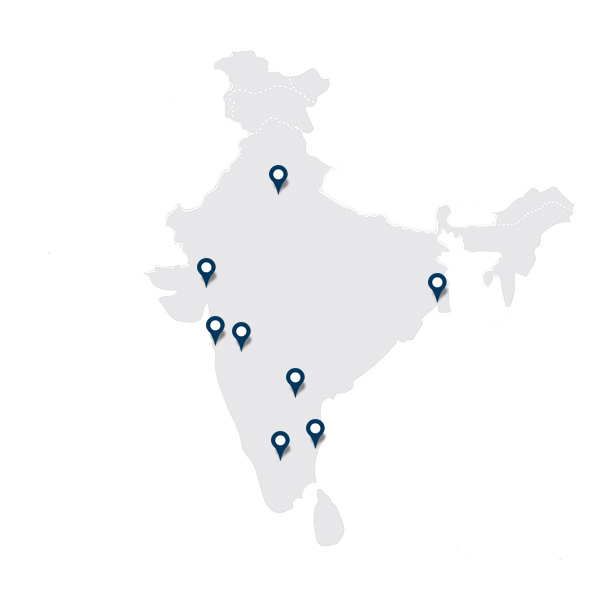Introduction
Dreaming of studying at a top university abroad but worried about the hefty price tag that is associated with it? You are not alone. Studying overseas is an incredible opportunity that opens doors to world-class education, global career prospects and life-changing experiences. But let’s be real – the costs can be daunting indeed. Tuition fees, living expenses, travel and plenty of other hidden costs can add up quickly.
That’s where education loans step in as a game-changer. They help bridge the financial gap, making your dream of studying abroad a reality without burdening your family’s life savings. With flexible repayment options and competitive interest rates, education loans empower students to invest in their future without immediate financial stress.
In this guide, we’ll walk you through everything you need to know about securing an education loan – from understanding different loan types and eligibility criteria to the application process, required documents and smart repayment strategies. By the end, you’ll be equipped with all the insights needed to make an informed decision and fund your education with confidence.
Why Choose an Education Loan to Study Abroad?
Studying abroad is a life-changing opportunity, offering exposure to diverse cultures, world-class education and global career prospects. However, financing international education requires meticulous planning at every step of the way.
Education loans provide a smart and structured way to cover expenses without relying entirely on personal savings. They not only make overseas education more accessible but also come with benefits that extend beyond just funding your studies. Learn more about why opting for an education loan is a wise decision.
World-Class Education Without Financial Barriers
Top universities worldwide offer premier courses, advanced research facilities and unparalleled networking opportunities. While international education requires significant investment, it is a long-term asset that enhances your career prospects and earning potential.
Education loans ensure that financial limitations do not stand in the way of your academic aspirations. Unlike self-funding, which may require large upfront payments, loans provide structured disbursements to cover tuition fees, accommodation, travel, insurance and daily expenses. With loan coverage for essentials like the cost of living in Ireland and other popular destinations, you can focus on your studies without financial stress, making the journey smoother and more rewarding.
Flexible Repayment Options
Strong Credit Profile For Future
Education loans do more than just fund your studies – they also help build your financial credibility. Timely repayment contributes to a strong credit history, which in turn plays a crucial role when applying for future financial requirements such as home loans, car loans or credit cards.
Maintaining a good credit record can be advantageous in many ways for students planning to work or settle abroad. It can make it easier to rent accommodation, secure lower interest rates on future loans and even fulfil specific visa or employment requirements. In essence, an education loan is not just an investment in academics but also a stepping stone towards long-term financial stability.
Types of Education Loans for Studying Abroad
Secured Loans
Secured loans require collateral, such as property, fixed deposits, or insurance policies, as a security against the borrowed amount. Since lenders have an asset as a guarantee, these loans come with lower interest rates and higher loan amounts. They are ideal for students needing substantial funding at more favourable terms, especially when planning to study in destinations with higher cost of living in the UK and other popular countries. Most nationalised and private banks offer secured loans and they typically cover tuition fees, living expenses, travel and other costs. However, the approval process can take longer due to collateral verification and other legal formalities.
Unsecured Loans
Unsecured loans do not require collateral, making them a great option for students who may not have assets to pledge. These loans are provided based on factors like academic performance, university ranking and the co-applicant’s financial profile.
While unsecured loans have quicker approval processes, they come with higher interest rates and stricter eligibility criteria. Private banks, non-banking financial companies (NBFCs) and international lenders typically offer these loans, making them accessible to a broader range of students.
Note: Both secured and unsecured loans have their advantages, so comparing interest rates, repayment terms and eligibility requirements is essential before applying.
Eligibility Criteria for Education Loans
Securing an education loan for studying abroad involves meeting specific eligibility requirements. These criteria ensure that applicants can repay the loan and are committed to their educational pursuits. The primary eligibility factors include academic qualifications, income stability and age limits.
Academic Requirements
Applicants must have secured admission to a recognised foreign university or institution. This is a fundamental prerequisite, as lenders require proof of enrolment before processing the loan application.
A strong academic record enhances loan approval chances. While specific requirements vary, a minimum of 50% marks in previous qualifying examinations is commonly expected.
Income Requirements
Most lenders mandate a co-applicant – typically a parent, guardian, or close relative with a stable income. The co-applicant’s financial standing assures the lender of the loan’s repayment capability.
The co-applicant must have an operational bank account in India with cheque-writing facilities, facilitating seamless loan transactions.
Age Criteria
Applicants are generally required to be within the age bracket of 18 to 35 years when applying for an education loan. This range ensures that the borrower has the potential for a longer working period post-education, aiding in timely loan repayment.
Meeting these eligibility criteria is crucial for a successful education loan application. Prospective students should thoroughly review the specific requirements of their chosen lender to ensure compliance and improve their chances of approval.
Step-by-Step Process to Apply for an Education Loan
Embarking on the journey to study abroad involves meticulous financial planning, with a streamlined education loan application process playing a pivotal role. Here’s a comprehensive guide to navigating the process with ease:
Research and Choose a Loan Provider
Begin the process by identifying banks and financial institutions offering overseas education loans. It is crucial to consider the following factors:
- Interest Rates: Compare the rates offered by various lenders to identify the most competitive option in the industry.
- Loan Tenure: Assess the repayment period to ensure it aligns well with your financial plans.
- Repayment Terms: Understand the flexibility of repayment options, including moratorium periods and EMI structures.
- Processing Fees: Be aware of any additional charges that may apply during loan processing.
Performing thorough research ensures you select the right type of loan that best fits your financial needs.
Gather Required Documents
Accurate and complete documentation is crucial for a smooth application process. Typically, lenders require:
- Academic Records: Mark sheets and certificates from previous educational qualifications.
- Proof of Admission: Offer or admission letter from the foreign institution you wish to join.
- Collateral Documents: Provide property papers or fixed deposit receipts for secured loans.
- Co-Applicant’s Financial Details: Income proof, bank statements and tax returns of the co-applicant.
- Identification Proof: Passport, Aadhaar Card, or any other valid ID proof.
Ensuring all documents are in order can expedite the approval process.
Submit Application
Depending on the lender’s procedures, applications can be submitted online and offline.
- Online: Fill out and upload scanned copies of documents through the lender’s official portals.
- Offline: Visit the bank branch to submit physical copies of the application form and documents.
Some lenders may also require a personal discussion to better understand your educational and financial plans.
Loan Approval and Disbursement
Once the application is submitted:
- Document Verification: The lender reviews all documents for authenticity and completeness.
- Approval Decision: Upon successful verification, the loan is sanctioned.
- Disbursement: Funds are released as per the institution’s fee schedule, either directly to the educational institution or to your account.
The entire process typically takes 2-4 weeks, depending on the lender and the comprehensiveness of your documentation. By diligently following these structured steps, you can secure an education loan that paves the way for your academic aspirations abroad.
Documents Required for Education Loans
Applying for an education loan involves submitting a set of essential documents that help lenders assess your eligibility and repayment capacity. Having all the necessary paperwork in place ensures a smooth approval process and avoids unnecessary delays.
The following list comprises all the key documents required for a successful loan application.
- Admission Proof: A confirmed offer letter from a recognised foreign university is mandatory to validate your admission and assure the lender that the loan is genuinely for educational purposes
- Academic Records and Transcripts include mark sheets, degree certificates and any applicable entrance exam scores.
- Collateral Documents (For Secured Loans): If opting for a secured loan, property papers, fixed deposit receipts, or insurance policies pledged as collateral are required since they serve as security for the lender, reducing risk and leading to better loan terms.
- Co-Applicant’s Financial Details: Submitting these details assures the lender of a stable financial backup for loan repayment. This consists of various proofs of income (salary slips, ITR, bank statements) from the co-applicant (usually a parent or guardian).
- Passport and Visa Copies: A valid passport is necessary as proof of identity. In addition to that, a visa copy (or visa application proof) may be required to confirm your eligibility to study abroad.
Ensuring these documents are accurate and complete will enhance your chances of a hassle-free loan approval process with the lending authority.
Top Banks and Financial Institutions Offering Loans
Securing an education loan is pivotal to achieving your dream of studying abroad. Various banks and financial institutions offer tailored loan schemes to cater to the diverse needs of students.
The following section provides a detailed overview of prominent lenders in this sector and their offerings:
1. Nationalised Banks
State Bank of India (SBI)
- Loan Schemes: SBI offers the ‘SBI Global Ed-Vantage’ and ‘SBI Student Loan’ schemes for students aiming to study abroad.
- Loan Amount: Up to ₹1.5 crore for the Global Ed-Vantage scheme.
- Interest Rates: Linked to the bank’s Marginal Cost of Funds-based Lending Rate (MCLR) with additional concessions for female students.
- Repayment Tenure: Up to 15 years.
- Moratorium Period: Course period plus 6 months.
Punjab National Bank (PNB)
- Loan Scheme: PNB offers the ‘PNB Udaan’ scheme for students pursuing higher education abroad.
- Loan Amount: Up to ₹1 crore.
- Interest Rates: Varies based on loan amount and course with exclusive concessions available for female students.
- Repayment Tenure: Up to 15 years.
- Moratorium Period: Course period plus 1 year.
2. Private Banks
ICICI Bank
- Loan Scheme: ICICI Bank provides education loans for overseas studies with flexible terms.
- Loan Amount: Up to ₹1 crore.
- Interest Rates: Starting from 11.5% per annum.
- Repayment Tenure: Up to 10 years.
- Moratorium Period: Course period plus 6 months.
Axis Bank
- Loan Scheme: Axis Bank offers education loans for students aiming to study abroad.
- Loan Amount: Up to ₹75 lakh.
- Interest Rates: Starting from 13.7% per annum.
- Repayment Tenure: Up to 15 years.
- Moratorium Period: Course period plus 1 year.
3. Non-Banking Financial Companies (NBFCs)
HDFC Credila
- Up to 100% financing, covering tuition fees and living expenses.
- Unsecured loans up to ₹75 lakh.
- Flexible repayment options with tenures up to 15 years.
- Loan sanction even before admission confirmation.
4. International Loan Providers
Prodigy Finance
- No co-signer or collateral required.
- Loans available for students from over 120 countries.
- Covers up to 100% of the cost of attendance.
- Competitive interest rates based on future earning potential.
How to Choose the Right Loan Provider
Compare Interest Rates and Processing Fees
Interest rates vary significantly across lenders, affecting your total repayment amount. While secured loans from banks generally offer lower interest rates, NBFCs and international lenders might have slightly higher rates but more flexible eligibility criteria. It is also crucial to check the processing fees – these can range from 0.5% to 2% of the loan amount and add to your initial expenses.
Evaluate Repayment Flexibility
A well-structured repayment plan can ease financial stress after graduation. Look for lenders offering a comfortable tenure, typically 10 to 15 years. A moratorium period, which is a grace period after graduation before EMIs start – can provide some breathing space while you secure a job. Some lenders also offer step-up EMI options, allowing repayments to start small and gradually increase as your income grows.
Check for Hidden Charges or Penalties
Many borrowers overlook the fine print, only to be surprised by hidden costs later. Some banks impose prepayment penalties, while others offer benefits for early repayment. It is essential to stay mindful of foreclosure charges, late payment fees and other additional costs that might increase your financial burden.
Customer Reviews and Feedback
Lender reputation and service quality matter as much as interest rates. Read student reviews on trusted platforms to understand real experiences with processing times, transparency and customer support. Speaking to peers who have availed of education loans can also provide valuable insights.
By evaluating these key factors, you can choose a loan provider that offers the best balance of affordability, flexibility and reliability – making your study abroad journey smoother and stress-free.
Tips to Increase Education Loan Approval Chances
Maintain a Strong Academic Profile: Lenders often view applicants with excellent academic records more favourably, as it indicates dedication and potential for success.
Apply Early to Avoid Delays: Initiating the loan application process well in advance ensures ample time for document verification and addresses any unforeseen issues, reducing the risk of delays.
Include a Financially Stable Co-Applicant: Having a co-applicant with a stable income and good credit can significantly enhance approval chances and may even result in a lower interest rate.
Provide Clear and Complete Documentation: Organising and submitting all required documents accurately, such as academic records, proof of admission and financial statements, demonstrates preparedness and facilitates a smoother approval process.
Focusing on these aspects can improve your likelihood of securing an education loan for your studies abroad.Repayment Options and Benefits
Moratorium Period
Most education loans offer a moratorium period, which encompasses the course duration plus an additional 6 to 12 months. During this time, borrowers are typically not required to make principal repayments, allowing them to focus on their studies without immediate financial pressure. However, interest often accrues during this period, which may be added to the principal amount upon repayment commencement.
EMI Options
Repayment of education loans is generally structured through Equated Monthly Installments (EMIs), which commence after the moratorium period. Lenders may offer flexible EMI plans, allowing borrowers to choose tenures that align with their anticipated income levels post-graduation. Some institutions provide options to start with lower EMIs that increase over time, accommodating the expected growth in a graduate’s earning capacity.
Tax Benefits
FAQs
Education loans typically cover:
Requirements differ by lender:
Lenders consider several factors:
Each lender has its own assessment criteria, so it's essential to discuss your specific situation with them.
Repayment terms vary:
In many countries, including India, borrowers can claim tax deductions on the interest paid for education loans under specific sections of the Income Tax Act. For instance, under Section 80E in India, the interest paid on education loans is deductible for up to 8 years.
Conclusion
Embarking on an international educational journey is both exciting and financially demanding. Education loans serve as pivotal instruments, enabling students to access world-class education without immediate financial constraints. By understanding the various loan types – secured and unsecured – and meeting eligibility criteria, students can navigate the application process more effectively.
Partnering with reputable banks and financial institutions ensures tailored loan solutions, while selecting the right loan provider involves careful comparison of interest rates, repayment terms and associated fees. Implementing strategies to enhance loan approval chances, such as maintaining a strong academic record and providing comprehensive documentation, further facilitates the process.
Additionally, being informed about repayment options and potential tax benefits aids in long-term financial planning. By approaching each step with diligence and informed decision-making, students can confidently pursue their aspirations of studying abroad, transforming educational dreams into reality.
To gain exclusive insights and personalised regarding the best loan options available for you, reach out to Fateh Education’s expert counsellors for an enriching counselling session. Conquer your dreams – minus the economic worries!


